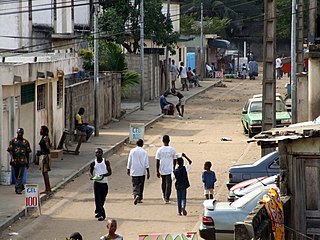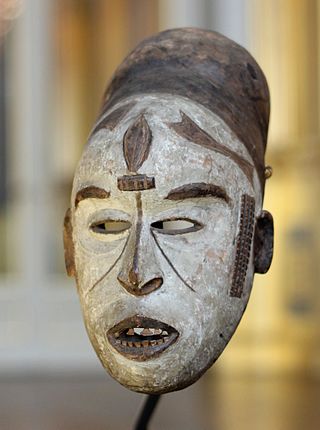Related Research Articles

African art describes the modern and historical paintings, sculptures, installations, and other visual culture from native or indigenous Africans and the African continent. The definition may also include the art of the African diasporas, such as: African-American, Caribbean or art in South American societies inspired by African traditions. Despite this diversity, there are unifying artistic themes present when considering the totality of the visual culture from the continent of Africa.
The diverse culture of Ivory Coast, a coastal West African country bordered by Ghana, Liberia, Mali, Burkina Faso, and Guinea, is exemplified by a multitude of ethnic groups, events, festivals, music, and art.
Seydou Keïta was a Malian photographer known for his portraits of people and families he took at his portrait photography studio in Mali's capital, Bamako, in the 1950s. His photographs are widely acknowledged not only as a record of Malian society but also as pieces of art.
Malick Sidibé was a Malian photographer noted for his black-and-white studies of popular culture in the 1960s in Bamako. Sidibé had a long and fruitful career as a photographer in Bamako, Mali, and was a well-known figure in his community. In 1994 he had his first exhibition outside of Mali and received much critical praise for his carefully composed portraits. Sidibé's work has since become well known and renowned on a global scale. His work was the subject of a number of publications and exhibited throughout Europe and the United States. In 2007, he received a Golden Lion Award for Lifetime Achievement at the Venice Biennale, becoming both the first photographer and the first African so recognized. Other awards he has received include a Hasselblad Award for photography, an International Center of Photography Infinity Award for Lifetime Achievement, and a World Press Photo award.

Georges Adéagbo is a Beninese sculptor known for his work with found objects.
Camille-Pierre Pambu Bodo, known as Bodo, was a painter and pastor from the Democratic Republic of Congo. He lived in Kinshasa. Bodo was one of the founders and key proponents of the Zaïre School of Popular Painting. His works, along with those of other artists, vigorously exemplify their belief in their capacity to create art that could change history.
Frédéric Bruly Bouabré, also known as Cheik Nadro, was an Ivorian artist.

Seni Awa Camara is a Senegalese sculptor from the Diola ethnic group. She was born in Bignona, where she still lives and works. She creates sculptures in clay in her front yard, then fires them in an open-hearth kiln before displaying them around her house. The pieces, ranging in size from 12 inches tall to 8 feet tall, represent personal symbols.

Barthélémy Toguo is a Cameroonian painter, visual and performing artist born in 1967. He currently splits his time living and working in both Paris, France and Bandjoun, Cameroon. He works in a variety of media aside from visual and performing arts including photographs, prints, sculptures, videos, and installations.

Yopougon, also known colloquially as Yop City, is a suburb of Abidjan, Ivory Coast. It is the most populous of the 10 urban communes of Abidjan and covers most of the western territory of the city. Yopougon is the only commune of Abidjan that spans both north and south sides of Ébrié Lagoon.

Untitled (L's), a public sculpture by American artist David Von Schlegell, is located on the Indiana University-Purdue University Indianapolis campus, which is near downtown Indianapolis, Indiana. The sculpture is located just north of Joseph Taylor Hall in a grassy courtyard adjacent to Michigan Street. Cavanaugh hall frames the courtyard to the west, the library and Business building are east of the courtyard. This sculpture was created in 1978, and installed at IUPUI in 1980. The sculpture is a Minimalist composition of three identical steel L's. The L structures have a vertical beam that is 55 feet (17 m) tall and a horizontal beam of 45 feet (14 m). The beams themselves are 16 inches (410 mm) high and 12 inches (300 mm) wide.
Gary Freeman (1937–2014), is an American sculptor from Indianapolis, Indiana. He is Professor Emeritus of Indiana University-Purdue University Indianapolis (IUPUI) and served as head of the Herron School of Art Sculpture Department for 33 years, from 1968 until his retirement in 2001.
Christian Lattier (1925–1978) was an Ivorian sculptor born in Grand Lahou, Côte d'Ivoire.
Jems Robert Koko Bi is an Ivorian sculptor.
The Contemporary African Art Collection (CAAC) is a private collection created in 1989 by Jean Pigozzi, an Italian businessman. As of May 2022, the collection was based in Geneva, Switzerland, but it "does not have a permanent exhibition venue".

Some African objects had been collected by Europeans for centuries, and there had been industries producing some types, especially carvings in ivory, for European markets in some coastal regions. Between 1890 and 1918 the volume of objects greatly increased as Western colonial expansion in Africa led to the removal of many pieces of sub-Saharan African art that were subsequently brought to Europe and displayed. These objects entered the collections of natural history museums, art museums and private collections in Europe and the United States. About 90% of Africa's cultural heritage is believed to be located in Europe, according to French art historians.

Zak Ové is a British-Trinidad visual artist who works between sculpture, film and photography, living in London and Trinidad. His themes reflect "his documentation of and anthropological interest in diasporic and African history, specifically that which is explored through Trinidadian carnival." In work that is "filtered through his own personal and cultural upbringing, with a black Trinidadian father and white Irish mother", he has exhibited widely in Europe, the United States and Africa, participating in international museum shows in London, Dakar, Paris, Dubai, Prague, Berlin, Johannesburg, Bamako and New York City. His father is the filmmaker Horace Ové and his sister is the actress Indra Ové.
The Musée des Amériques, formerly known as the Musée des Jacobins, is the town museum in Auch, the capital of the Gers department in France. It is located in the old city between the riverbank and the Cathédrale Sainte-Marie d'Auch. It houses France's second biggest collection of Pre-Columbian art after the quai Branly, with which it has collaborated for many years. The museum garden is a 1600 square metre parc à la française containing plants brought back from the Americas by the Conquistadors.

Valérie Oka was an Ivorian artist and designer.
References
- ↑ https://eltrueno.com.py/2021/09/23/el-maestro-de-nekedi-costa-de-marfil/.
{{cite web}}: Missing or empty|title=(help) - ↑ https://eltrueno.com.py/2021/09/23/el-maestro-de-nekedi-costa-de-marfil/.
{{cite web}}: Missing or empty|title=(help) - ↑ https://www.jstor.org/stable/20447735.
{{cite web}}: Missing or empty|title=(help) - ↑ "CAA CART".
- ↑ "JSTOR".
- ↑ "Taylor and Francis Online".
- ↑ https://eltrueno.com.py/2021/09/23/el-maestro-de-nekedi-costa-de-marfil/.
{{cite web}}: Missing or empty|title=(help) - ↑ https://www.caacart.com/artiste/guebehi-nicolas-damas-emile/.
{{cite web}}: Missing or empty|title=(help) - ↑ "MIT Press Direct".
- ↑ "Rice Gallery".
- ↑ "Artsy".
- ↑ "De Nieuwe Kerk Amsterdam".